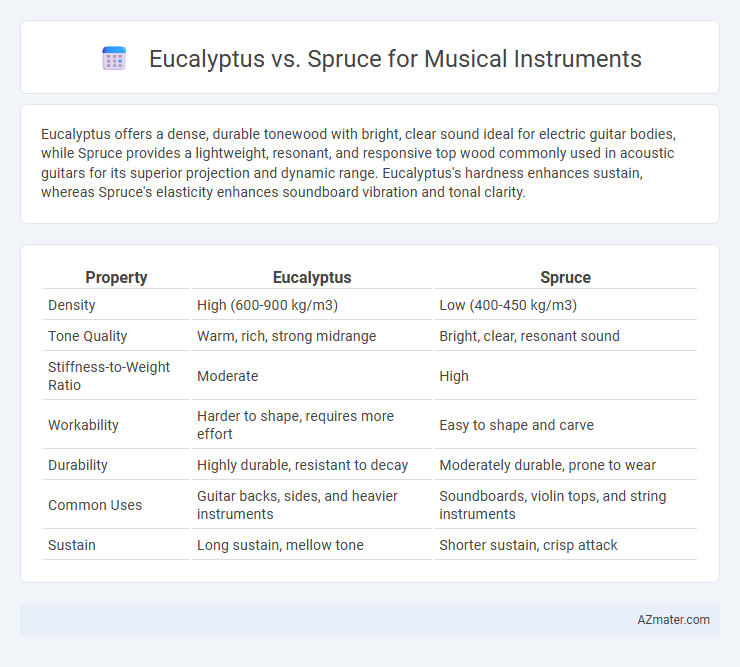Eucalyptus offers a dense, durable tonewood with bright, clear sound ideal for electric guitar bodies, while Spruce provides a lightweight, resonant, and responsive top wood commonly used in acoustic guitars for its superior projection and dynamic range. Eucalyptus's hardness enhances sustain, whereas Spruce's elasticity enhances soundboard vibration and tonal clarity.
Table of Comparison
| Property | Eucalyptus | Spruce |
|---|---|---|
| Density | High (600-900 kg/m3) | Low (400-450 kg/m3) |
| Tone Quality | Warm, rich, strong midrange | Bright, clear, resonant sound |
| Stiffness-to-Weight Ratio | Moderate | High |
| Workability | Harder to shape, requires more effort | Easy to shape and carve |
| Durability | Highly durable, resistant to decay | Moderately durable, prone to wear |
| Common Uses | Guitar backs, sides, and heavier instruments | Soundboards, violin tops, and string instruments |
| Sustain | Long sustain, mellow tone | Shorter sustain, crisp attack |
Introduction: Eucalyptus vs Spruce in Musical Instrument Crafting
Eucalyptus and spruce are prominent hardwoods in musical instrument crafting, each offering distinct acoustic properties and tonal qualities. Spruce is renowned for its light weight, excellent stiffness-to-weight ratio, and bright, resonant sound, making it the preferred choice for soundboards in guitars, violins, and pianos. Eucalyptus provides a denser, more durable alternative with warm, rich tonal characteristics, often utilized in electric guitar bodies and percussion instruments for enhanced sustain and resonance.
Wood Properties: Acoustic Qualities of Eucalyptus and Spruce
Eucalyptus wood offers a dense, strong grain that produces a warm, rich tone with good sustain, making it suitable for certain musical instruments like guitars and ukuleles. Spruce, renowned for its lightweight, fine-grained structure, provides exceptional resonance, clarity, and dynamic range, making it the preferred topwood for violin, guitar, and piano soundboards. The acoustic properties of spruce contribute to brighter, more articulate sound projection, while eucalyptus often yields a darker, mellower timbre.
Growth and Sustainability: Sourcing Eucalyptus and Spruce
Eucalyptus grows rapidly, reaching maturity within 7 to 10 years, making it a highly sustainable option for musical instrument sourcing compared to spruce, which typically takes 40 to 80 years to mature. Sustainable eucalyptus plantations can be managed with minimal environmental impact, supporting continuous supply without deforestation. Spruce, renowned for its tonal qualities, often relies on old-growth forests, posing challenges for sustainable harvesting and long-term availability.
Tonal Characteristics: Sound Differences Explained
Eucalyptus wood produces bright, clear tones with strong midrange presence and good projection, making it suitable for instruments requiring articulate sound. Spruce is highly valued for its balanced tonal qualities, offering warmth, clarity, and a dynamic range that enhances resonance and sustain in guitars and violins. The choice between eucalyptus and spruce affects the instrument's voice, with eucalyptus emphasizing sharp attack and clarity, while spruce provides a smooth, rich, and versatile sound profile.
Durability and Longevity in Instruments
Eucalyptus wood offers exceptional durability and resistance to wear, making it a reliable choice for musical instruments that require long-lasting performance. Spruce, known for its lightweight and resonant properties, provides excellent tonal quality but is generally softer and less durable compared to eucalyptus. Instruments crafted from eucalyptus tend to withstand moisture and physical impact better, resulting in enhanced longevity and reduced maintenance over time.
Workability: Crafting Challenges and Benefits
Eucalyptus offers a dense grain structure that provides durability and a distinct tone but presents challenges in workability due to its hardness and tendency to splinter, requiring sharp tools and careful handling. Spruce, known for its lightweight and elastic properties, is favored for soundboards because of its ease in carving, shaping, and fine tuning despite being softer and more prone to dents. Both woods impact the instrument's acoustic qualities, with eucalyptus demanding skilled craftsmanship while spruce allows more versatility in design and refinements.
Popular Musical Instruments Using Eucalyptus vs Spruce
Spruce is predominantly used for the soundboards of popular musical instruments like acoustic guitars, violins, and pianos due to its exceptional resonance and bright tonal quality. Eucalyptus, while less common, is favored in some handcrafted string instruments and percussion for its durability and warm, balanced sound. The choice between eucalyptus and spruce significantly influences the instrument's tonal characteristics and projection, with spruce offering superior clarity and eucalyptus providing a unique tonal warmth.
Aesthetic Appeal: Appearance and Grain Patterns
Eucalyptus wood features a warm, rich color with intricate, swirling grain patterns that enhance the visual appeal of musical instruments, offering a natural elegance and uniqueness to each piece. Spruce, renowned for its lighter, pale tone and straight, uniform grain, provides a classic, clean aesthetic often favored in acoustic instrument soundboards for both beauty and functionality. The contrasting grain textures and hues of eucalyptus and spruce influence the overall artistic character, making the choice essential for musicians and luthiers focused on distinctive instrument design.
Cost and Availability for Luthiers
Eucalyptus offers a cost-effective alternative to traditional spruce, with lower price points due to its fast growth and widespread availability in regions like Australia and California. Spruce remains the preferred choice for luthiers seeking superior tonal quality, but its higher cost and limited availability in certain markets can impact budget and project timelines. For budget-conscious luthiers, eucalyptus provides easier procurement and affordability without compromising structural integrity.
Choosing the Right Wood: Eucalyptus or Spruce?
Eucalyptus offers a dense, bright tonal quality with strong projection, making it suitable for instruments requiring durability and a crisp sound, while spruce is favored for its superior resonance, balanced warmth, and responsiveness, ideal for acoustic guitars and violins. Spruce's lightweight flexibility provides excellent dynamic range and clarity, whereas eucalyptus excels in producing a sharper attack and sustain. Selecting between eucalyptus and spruce depends on the desired tonal characteristics and instrument type, with spruce often preferred for classical tone and eucalyptus for modern, robust sound profiles.

Infographic: Eucalyptus vs Spruce for Musical Instrument
 azmater.com
azmater.com